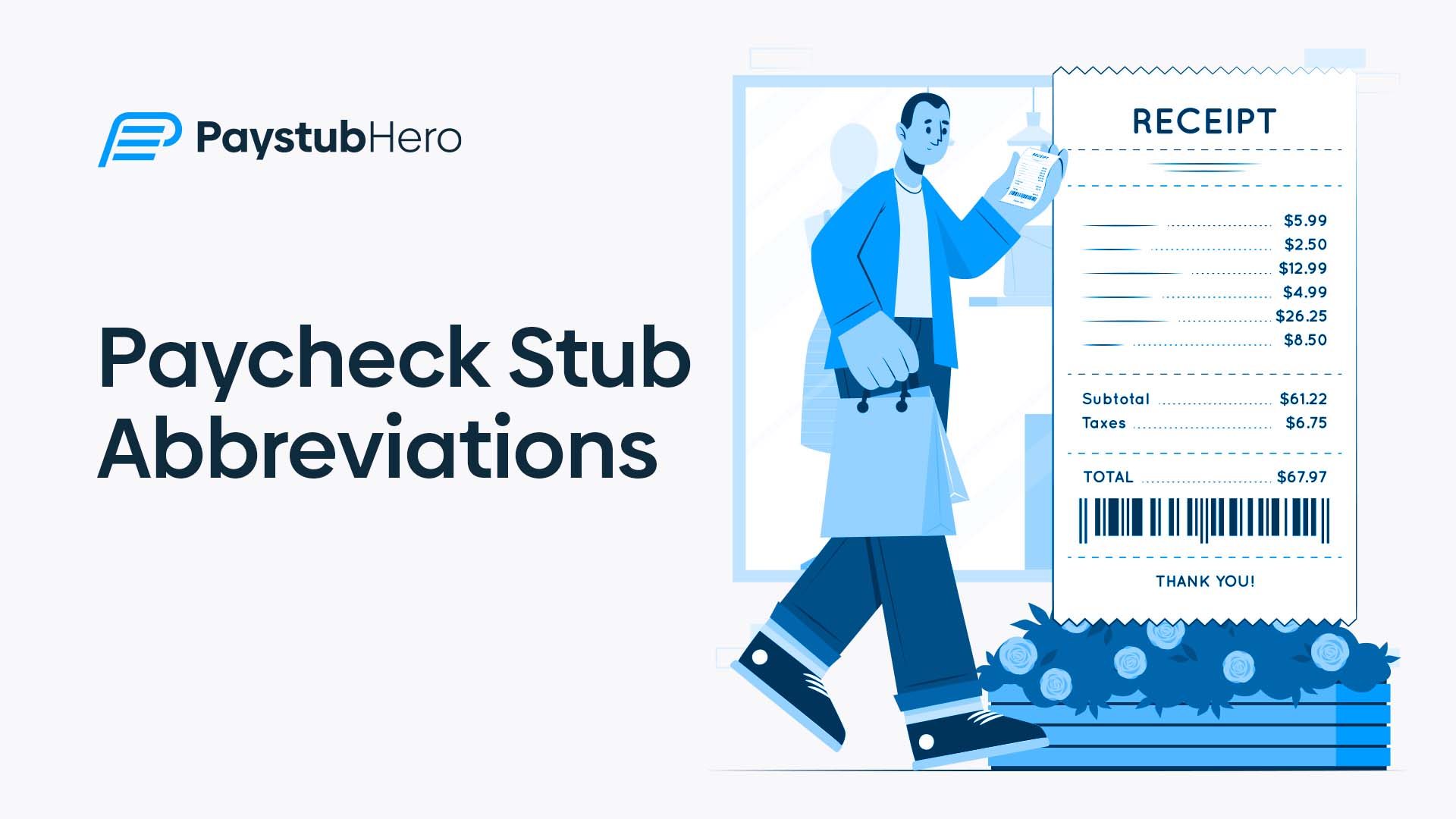Whether you’re a seasoned worker or a fresh graduate stepping into the workforce, paycheck stubs can be confusing with their multitude of abbreviations and numerical representations. These paycheck stub abbreviations, however, form the language of your income, and developing an understanding of them is pivotal to managing your finances effectively.
The language of paycheck stubs is like an encrypted message. At first glance, it might seem like a tangled web of terms and numbers, but once you understand the meaning behind these abbreviations, the whole picture becomes much clearer. These abbreviations represent everything from your gross pay to the taxes deducted and ultimately, your net take-home pay.
Understanding what these abbreviations signify can empower you with better financial control, aiding you in informed decision-making about your income and expenses.
This article serves as your guide, helping you decode the paycheck stub abbreviations and giving you a clearer picture of your earnings, deductions, and net income. By the end of this article, you’ll be well-equipped to understand the language of your paycheck, helping you plan, budget, and manage your finances better.
Let’s embark on this journey of financial literacy together and demystify the abbreviations that once seemed perplexing.
From FICA to FED OASDI/EE, from pay advice to net pay, and from EE to the real meaning of paystubs – this guide covers all the necessary bases, helping you to not only define these terms but to truly understand their impact on your income.
Table of Contents
- Introduction: The ABCs of Paycheck Stub Abbreviations
- Deciphering Paycheck Stub Abbreviations: Starting the Journey with FICA
- FED OASDI/EE: Unraveling a Complex Acronym for a Simpler Understanding
- Pay Advice: Your Financial Compass Guiding You Through the Sea of Numbers
- Net Pay: The Bottom Line of Your Paycheck Story
- The “EE” Puzzle: Employee Abbreviation Unpacked and Understood
- Unraveling Paycheck Stub Abbreviations: A Step-by-Step Guide Towards Financial Clarity
- PaystubHero: Simplifying Paycheck Stub Abbreviations and Empowering Financial Understanding
Deciphering Paycheck Stub Abbreviations: Starting the Journey with FICA
One of the first abbreviations you’ll likely come across when you examine your paycheck stub is FICA, the Federal Insurance Contributions Act. This term plays a vital role in the complex world of paycheck stub abbreviations.
FICA is the legal framework that determines the amount deducted from your pay for Social Security and Medicare. These are mandatory contributions that go towards funding these crucial societal support systems.
While these deductions may initially seem like a slice of your hard-earned money being taken away, they essentially serve as a government-mandated retirement savings plan. In the grand scheme of things, understanding what FICA means and its role in your paycheck can help you appreciate why this deduction is vital for your long-term financial health.
But what does this mean for you, right here and now? Well, it signifies the money set aside from your paycheck for your future. This future could entail unexpected medical expenses covered by Medicare, or retirement benefits through Social Security.
Understanding FICA is not just about knowing what the abbreviation stands for, but it’s also about comprehending the impact it has on your current earnings and future financial security. This understanding serves as the first step towards gaining control over your income, setting the stage for greater financial literacy and empowerment.
FED OASDI/EE: Unraveling a Complex Acronym for a Simpler Understanding
As you delve deeper into the world of paycheck stub abbreviations, one term you’re bound to come across is FED OASDI/EE. At first glance, this term might seem daunting. However, with a little explanation, it’s not as complex as it first appears.
FED OASDI/EE stands for Federal Old Age, Survivors, and Disability Insurance/Employee’s contribution. This abbreviation essentially represents your contribution to the Social Security system. It’s your share of the cost that goes towards supporting current retirees, disabled workers, and surviving spouses and children of deceased workers.
While the term may seem complicated, its purpose is actually quite simple: to secure a part of your paycheck for the benefit of society’s most vulnerable individuals.
Understanding the role of FED OASDI/EE on your paycheck stub is crucial for a couple of reasons. Firstly, it helps you to better comprehend where your paycheck deductions are going, adding a layer of transparency to your income. Secondly, it can foster a greater sense of responsibility and contribution to the welfare of society at large.
Ultimately, FED OASDI/EE is a critical term in the lexicon of paycheck stub abbreviations.
By knowing its meaning and implications, you’re one step closer to decoding your pay stub, and thus, mastering your financial awareness and planning. Don’t let the complexity of the term intimidate you. With this newfound knowledge, you’re already on your way to better financial literacy.
Pay Advice: Your Financial Compass Guiding You Through the Sea of Numbers
As you navigate the maze of paycheck stub abbreviations, the term “pay advice” might pop up. Though it’s not an abbreviation, understanding its meaning is critical in comprehending your paycheck stub.
A pay advice is essentially a detailed breakdown or a summary of your earnings for a specific period. It reveals your gross pay, deductions, and the final net pay, acting as a snapshot of your income and outgoings for that period. It’s like a financial compass, offering direction and clarity amidst a sea of numbers.
Comprehending your pay advice is crucial as it does more than just detail your paycheck’s components. It is a document that can help you ensure you’re being correctly compensated for your efforts and whether the right deductions are being made. Understanding the information on your pay advice can help you recognize any discrepancies or errors, enabling you to take corrective action promptly.
Additionally, reviewing your pay advice regularly can offer valuable insights into your financial health. You can track changes in your income or deductions, identify trends, and even plan for future financial needs. It’s an indispensable tool in your financial toolkit, helping you make more informed decisions and better manage your money.
In conclusion, while pay advice might not be an abbreviation, it is a vital term in the realm of paycheck stubs.
Understanding its importance and relevance can provide you with a higher level of control over your finances. It’s your financial compass, guiding you through the complexities of your paycheck stub and towards a better understanding of your income.
Net Pay: The Bottom Line of Your Paycheck Story
In the landscape of paycheck stub abbreviations, the term ‘net pay’ is your final destination, the bottom line in the narrative of your income. While it is one of the simpler terms on your pay stub, understanding its significance is key to managing your financial health effectively.
Net pay, also referred to as take-home pay, is the final amount that lands in your bank account after all deductions have been made. These deductions can include federal and state taxes, insurance premiums, retirement contributions, and any other mandatory or voluntary deductions.
Understanding net pay is vital because this is the actual amount you have for your living expenses, savings, and discretionary spending.
By focusing on your net pay, you can plan your monthly budget effectively, ensuring that your expenses do not exceed your income. It also gives you a realistic view of your financial capabilities, helping you to make wise financial decisions, from daily purchases to long-term investments.
Moreover, by comparing your net pay over time, you can observe any changes that might occur. Whether it’s a salary raise reflecting positively or an increase in tax deductions impacting your income, your net pay tells the story. It’s a gauge that helps you assess if your financial health is improving or if there are areas of concern that need to be addressed.
In essence, net pay is the final piece of the paycheck puzzle. It’s the term that brings your entire paycheck story together, providing a clear picture of your financial standing. Understanding your net pay is an essential part of financial literacy, offering you the information necessary to plan, budget, and ensure financial security.
The “EE” Puzzle: Employee Abbreviation Unpacked and Understood
As you continue on your journey through the world of paycheck stub abbreviations, you’re likely to encounter the abbreviation “EE.” Despite its simple appearance, it can cause quite a bit of confusion. However, the “EE” puzzle isn’t as complicated as it initially seems.
The term “EE” stands for “employee.” It’s a short, simple term used quite frequently in the world of pay stubs and other payroll documents. “EE” often appears alongside other abbreviations, such as in FED OASDI/EE, where it signifies the portion of Social Security contributions that come directly from the employee’s paycheck.
Comprehending the meaning of “EE” is crucial as it provides context to other terms on your pay stub. Understanding that “EE” signifies you, the employee, can provide a layer of clarity to other deductions or contributions listed.
This understanding can help you differentiate between your contributions and those made by your employer, thereby giving you a more complete picture of your overall compensation package.
Moreover, having a clear grasp of what “EE” represents can help you understand where your money is going and why. It assists in making sense of the deductions from your gross pay and how they contribute to your net pay.
Whether it’s your contribution towards retirement plans, taxes, or insurance, the “EE” abbreviation plays a crucial role in understanding these deductions.
In essence, the term “EE,” while short and seemingly simple, holds substantial importance in decoding paycheck stub abbreviations. Its understanding paves the way to a better comprehension of your paycheck and a greater command over your finances. Thus, the puzzle that is “EE” isn’t so puzzling after all, but rather a stepping stone towards financial literacy.
Unraveling Paycheck Stub Abbreviations: A Step-by-Step Guide Towards Financial Clarity
Decoding paycheck stub abbreviations can seem like a daunting task. However, with a systematic approach, you can transform this challenge into an achievable and enlightening exercise.
Here’s a simple, step-by-step guide to unraveling paycheck stub abbreviations and gaining a comprehensive understanding of your income.
- Begin with Gross Pay: This is the first figure you’ll see on your paycheck and represents your total earnings before any deductions are made. It’s the starting point of your paycheck journey.
- Identify and Understand Deductions: Next, pay close attention to the various abbreviations that represent deductions from your gross pay, such as FICA and FED OASDI/EE. These represent mandatory deductions like Social Security and Medicare, as well as any voluntary deductions you might have chosen.
- Find your Net Pay: After all deductions, your net pay is what you’re left with. It’s the final destination in your paycheck journey and the amount you can actually spend or save. Understanding your net pay is key to effective budgeting and financial planning.
- Check the Details: Don’t overlook your pay advice, which offers more detailed insights into your earnings and deductions. This can help you confirm that you’re being compensated correctly and that all deductions are accurate.
By following these steps, you can transform the daunting maze of paycheck stub abbreviations into a navigable map towards financial understanding. It’s about shifting from merely recognizing abbreviations to comprehending their implications on your earnings, deductions, and ultimately, your financial well-being.
Remember, understanding paycheck stub abbreviations isn’t an academic exercise. Instead, it’s a vital life skill that equips you with the knowledge to effectively manage your income, plan for the future, and ensure you’re getting paid correctly.
By following these simple steps, you’re on your way to becoming fluent in the language of paycheck stub abbreviations and taking control of your financial narrative.
PaystubHero: Simplifying Paycheck Stub Abbreviations and Empowering Financial Understanding
In the sea of paycheck stub abbreviations, the journey to understanding your income and deductions can sometimes feel like a daunting endeavor. However, you’re not alone on this journey.
PaystubHero, a leading online payroll software, is committed to helping individuals, especially entrepreneurs, freelancers, small businesses, and independent contractors, simplify and understand their paycheck stubs.
PaystubHero is designed with user-friendliness in mind, presenting paycheck information in a clear, concise, and easy-to-understand format. It eliminates the complexity typically associated with paycheck stubs, helping you focus on what matters: understanding your income and managing your financial health effectively.
PaystubHero goes beyond providing a mere paycheck stub. It serves as a comprehensive tool that aids in understanding paycheck stub abbreviations, ensuring accurate calculations, and generating necessary financial documentation with ease. You don’t need a degree in finance to understand your paycheck stub.
With PaystubHero, you’re empowered with the tools and resources necessary to navigate the world of paycheck abbreviations with ease.
And the best part? It’s incredibly easy to use. Simply enter your company and employee information, and PaystubHero handles the rest. The calculations are done automatically, ensuring accuracy and saving you time and effort. It’s a robust yet simplified solution for individuals and small businesses who may not have access to complex payroll software.
So, are you ready to unlock the secrets of your paycheck stub abbreviations? Don’t let the jargon deter you from understanding your hard-earned money.
Partner with PaystubHero and take control of your financial journey. You’ve got a hero in your corner, making the process as easy as 1-2-3.
Frequent Asked Questions
- What do the abbreviations on my paystub mean?
- The abbreviations on your paystub represent various deductions and contributions. For instance, FICA stands for Federal Insurance Contributions Act (Social Security and Medicare), while FED OASDI/EE refers to your contribution to the Social Security system.
- What are payroll codes?
- Payroll codes are specific identifiers used in payroll processing. They can refer to different types of pay, deductions, benefits, or departments within a company, aiding in accurate payroll calculations and record-keeping.
- How do you read a pay stub?
- Start by checking your gross pay at the top, then move down to understand various deductions (like taxes, insurance, and retirement contributions). The remaining amount after these deductions, known as net pay, is your take-home income.
- What are the 5 mandatory deductions from your paycheck?
- The five mandatory deductions typically include:
- Federal income tax
- State income tax (where applicable)
- Social Security tax (FICA)
- Medicare tax (also part of FICA)
- Local taxes (where applicable)
- The five mandatory deductions typically include:
- Is it better to claim 1 or 0?
- If you claim 1, less tax is withheld from your paycheck, giving you a higher take-home pay. If you claim 0, more tax is withheld, potentially leading to a larger tax refund. It depends on your personal financial situation and preferences.
- What are 3 common payroll deductions?
- Three common payroll deductions are:
- Federal, state, and local taxes
- Social Security and Medicare contributions (FICA)
- Health insurance premiums
- Three common payroll deductions are:








